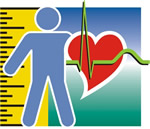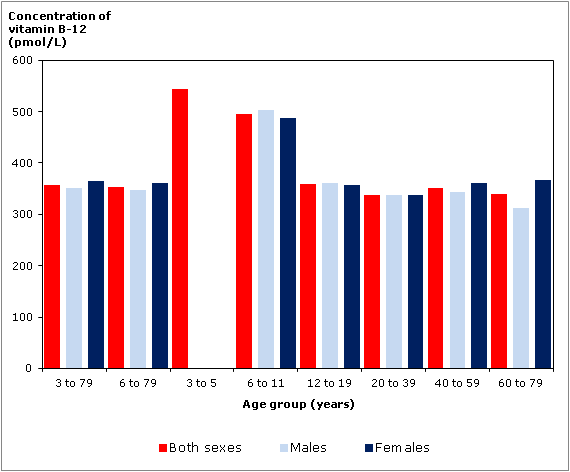Vitamin B12 status of Canadians, 2009 to 2011
Archived Content
Information identified as archived is provided for reference, research or recordkeeping purposes. It is not subject to the Government of Canada Web Standards and has not been altered or updated since it was archived. Please "contact us" to request a format other than those available.

According to blood sample data collected by the Canadian Health Measures Survey (CHMS), 96% of Canadians aged 3 to 79 had sufficient vitamin B12 levels in 2009 to 2011.
Vitamin B12 plays an essential role in many processes in the human body, including the formation of red blood cells, certain enzyme reactions and neurological functioning.1 As a water-soluble vitamin it is essential that its stores are replenished in the body through diet or supplementation. Vitamin B12 deficiency can manifest itself as anemia and in some cases cause permanent neurological damage.2 Deficiency is most commonly caused by low intake of vitamin B12, but can also result from malabsorption,3 certain intestinal disorders, low presence of enzymes or binding proteins, and the use of certain medications.4
Levels of vitamin B12 in Canadians
Based on results from the 2009 to 2011 Canadian Health Measures Survey (CHMS), Canadians aged 3 to 79 had, on average, 358 pmol/L of vitamin B12 in their blood. For both sexes, the vitamin B12 levels were highest for children aged 3 to 5, followed by 6 to 11 year olds (Chart 1). Vitamin B12 levels were almost identical for adolescents and adults aged 12 to 79. No significant differences were found between males and females, except for older adults aged 60 to 79 where females had significantly higher levels of vitamin B12 than their male counterparts (367 pmol/L for females compared to 313 pmol/L for males).
Chart 1
Average vitamin B12 concentration, by age group and sex, household population aged 3 to 79, Canada, 2009 to 2011

Note: The sample size for 3 to 5 year olds produces reliable national estimates for both sexes combined only.
Source: Canadian Health Measures Survey, 2009 to 2011. The CHMS collects health information on the Canadian household population aged 3 to 79.
Vitamin B12 sufficiency in Canadians
Sufficient vitamin B12 levels (greater than or equal to Health Canada's recommendation of 148 pmol/L1) were found in 96% of Canadians (Chart 2). For both sexes, close to 100% of 3 to 5 year olds and 6 to 11 year olds had sufficient vitamin B12. The prevalence of vitamin B12 sufficiency did not differ significantly between the other age groups, ranging from 97% among 12 to 19 year olds to 95% among 40 to 79 year olds. There was no significant difference in the prevalence of sufficient vitamin B12 levels between the sexes.
Chart 2
Percentage of vitamin B12 sufficiency,† by age group and sex, household population aged 3 to 79, Canada, 2009 to 2011

† Based on Health Canada recommended levels of vitamin B121
Note: The sample size for 3 to 5 year olds produces reliable national estimates for both sexes combined only.
Source: Canadian Health Measures Survey, 2009 to 2011. The CHMS collects health information on the Canadian household population aged 3 to 79.
Vitamin B12 supplement use
Among Canadians aged 3 to 79, 19% reported taking a vitamin B12 supplement, with consumption highest among 3 to 5 year olds (29%) and lowest among 12 to 19 year olds (12%) (data not shown). Between males and females there was no significant difference in supplementation, with the exception of the 60 to 79 year old age group within which females were more likely to take a vitamin B12 supplement. The levels of vitamin B12 were approximately 70 pmol/L higher in those who were taking a vitamin B12 supplement. Sufficient vitamin B12 levels were also more prevalent in those taking a supplement.
About vitamin B12
The main source of vitamin B12 is animal-based foods such as meat, fish, eggs, and dairy products. In addition, some vegetable-based foods have been fortified with vitamin B12.1 Individuals who do not consume these foods are more susceptible to vitamin B12 deficiency.2 Supplementation of vitamin B12 is possible through oral multivitamins, dedicated vitamin B12 supplements, or subcutaneous injection. The CHMS measured the vitamin B12 concentration in blood serum (in picomoles per litre - pmol/L) on a nationally representative population sample.
References
- Health Canada. Vitamin B12. Available at: http://www.hc-sc.gc.ca/fn-an/surveill/nutrition/measures-mesures/vit_b12-eng.php (accessed August 8, 2012).
- MacFarlane AJ, Greene-Finestone LS, Shi Y. Vitamin B-12 and homocysteine status in a folate-replete population: results from the Canadian Health Measures Survey. American Journal of Clinical Nutrition. 2011;94(4):1079-87.
- Allen LH. How common is vitamin B-12 deficiency? American Journal of Clinical Nutrition. 2009;89(2):693S-6S.
- Ito T, Jensen RT. Association of long-term proton pump inhibitor therapy with bone fractures and effects on absorption of calcium, vitamin B12, iron, and magnesium. Current Gastroenterology Reports. 2010;12(6):448-57.
For more information on the Canadian Health Measures Survey, please contact Statistics Canada's National Contact Centre (toll-free 1-800-263-1136; 613-951-8116; infostats@statcan.gc.ca).
- Date modified:
